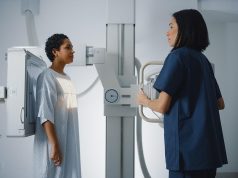Fewer benign biopsies necessary with DBT compared with full-field digital mammography
THURSDAY, March 21, 2019 (HealthDay News) — Digital breast tomosynthesis (DBT) can reduce the rate of benign biopsies without affecting cancer detection compared with full-field digital mammography (FFDM), according to a study published online March 19 in Radiology.
Nisha Sharma, M.B.Ch.B., from Seacroft Hospital in Leeds, England, and colleagues conducted a prospective study involving women who underwent FFDM or screening breast magnetic resonance imaging (MRI) and were recalled. After recall, the patients underwent a breast examination, additional imaging, and biopsy if necessary. FFDM was performed at the screening appointment, and DBT images were acquired when participants attended a screening assessment within three weeks after FFDM. DBT images were analyzed in isolation and in conjunction with FFDM and any additional images.
A total of 30,933 women underwent FFDM during the study period. Overall, 1,470 were recalled (recall rate, 4.8 percent); after application of exclusion criteria, 827 were included. The researchers found that 145 breast cancers were detected (142 with FFDM, two with DBT, and one with surveillance MRI). There were 571 breast biopsies resulting from triple assessment without DBT, enabling detection of 142 cancers. The addition of DBT would result in 298 biopsies and detection of 142 cancers, reducing the proportion of biopsies from 69 to 36 percent.
“Our study validates that DBT can help in the diagnostic workup of mammographic abnormalities and reduce harm to women through fewer false positive biopsies without any reduction in the cancer detection rate,” Sharma said in a statement.
One author disclosed financial ties to the medical device industry.
Copyright © 2019 HealthDay. All rights reserved.








